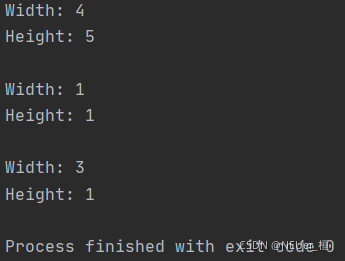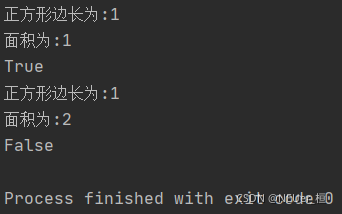一篇文章带你了解Python中的类
目录
- 1、类的定义
- 2、创建对象
- 3、继承
- 总结
1、类的定义
创建一个rectangle.py文件,并在该文件中定义一个Rectangle类。在该类中,__init__表示构造方法。其中,self参数是每一个类定义方法中的第一个参数(这里也可以是其它变量名,但是Python常用self这个变量名)。当创建一个对象的时候,每一个方法中的self参数都指向并引用这个对象,相当于一个指针。在该类中,构造方法表示该类有_width和_height两个属性(也称作实例变量),并对它们赋初值1。
__str__方法表示用字符串的方式表示这个对象,方便打印并显示出来,相当于Java中的类重写toString方法。其中,__init__和__str__是类提供的基本方法。
class Rectangle:
# 构造方法
def __init__(self, width=1, height=1):
self._width = width
self._height = height
# 状态表示方法
def __str__(self):
return ("Width: " + str(self._width)
+ "\nHeight: " + str(self._height))
# 赋值方法
def setWidth(self, width):
self._width = width
def setHeight(self, height):
self._height = height
# 取值方法
def getWidth(self):
return self._width
def getHeight(self):
return self._height
# 其它方法
def area(self):
return self._width * self._height
2、创建对象
新建一个Test.py文件,调用rectangle模块中的Rectangle的类。
import rectangle as rec r = rec.Rectangle(4, 5) print(r) print() r = rec.Rectangle() print(r) print() r = rec.Rectangle(3) print(r)
接着输出结果:

打印Rectangle类的对象直接调用了其中的__str__方法。上图展示了初始化Rectangle对象时,构造方法中参数的三种不同方式。
创建一个对象有以下两种形式,其伪代码表示为:
1)objectName = ClassName(arg1,arg2,…)
2)objectName = moduleName.ClassName(arg1,arg2,…)
变量名objectName表示的变量指向该对象类型。
3、继承
如果往父类中增加属性,子类必须先包含刻画父类属性的初始化方法,然后增加子类的新属性。伪代码如下:
super().__ init __ (parentParameter1,…,parentParameterN)
新建一个square.py文件:
import rectangle as rec
class Square(rec.Rectangle):
def __init__(self, square, width=1, height=1):
super().__init__(width, height)
self._square = square
def __str__(self):
return ("正方形边长为:" + str(self._width) +
"\n面积为:" + str(self._square))
def isSquare(self):
if self._square == self.getWidth() * self.getWidth():
return True
else:
return False
s = Square(1)
print(s)
print(s.isSquare())
s = Square(2)
print(s)
print(s.isSquare())
输出:

以上内容参考自机械工业出版社《Python程序设计》~
总结
本篇文章就到这里了,希望能够给你带来帮助,也希望您能够多多关注hwidc的更多内容!
【本文由:日本服务器 欢迎转载】